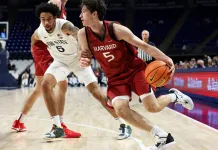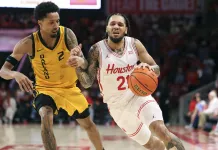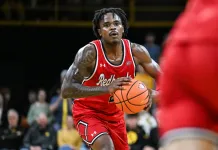Big East
The Big East Conference is a true college basketball powerhouse. It also just so happens to contain the reigning two-time National Champions. The UConn Huskies will attempt to run it back for a third straight season, as they’ve gone 68-11 overall and 31-9 in conference play over the last two seasons. As good as the 2023 title team was, they were better in 2024, going 37-3 and 18-2 in league play.
So, that’s the standard that everybody else in the conference will attempt to emulate. For all of the good teams in the conference, only three made the NCAA Tournament last season and the other two, Creighton and Marquette, bowed out in the Sweet 16. St. John’s, at least from metric sites like Bart Torvik and KenPom, was one of the biggest tourney snubs. But, the problem with this conference is that they all grade strongly, but spend time cannibalizing each other during conference play.
UConn was the only team with fewer than six losses. The aforementioned Red Storm went 20-13 overall and 11-9 in conference, but ranked in the top 20 per Torvik and 21st for KenPom. The only other top-36 team for KenPom to miss the tournament was Wake Forest.
Torvik and Pomeroy both had nine of the 11 teams in their top 61 last season. UConn’s personnel losses may level the playing field a little bit, but every game will be a grind night in and night out and the members of this league often have big showcase games in the non-conference, especially with the Big East-Big 12 Battle.
The depth of this conference is a reflection of the talent and also the coaching, as there are a lot of strong bench bosses in the Big East. What will be interesting to see is if the second-year guys Rick Pitino (St. John’s), Kim English (Providence), and Ed Cooley (Georgetown), and third-year guys Shaheen Holloway (Seton Hall), Kyle Neptune (Villanova), Sean Miller (Xavier), and Thad Matta (Butler) can take their teams to the next level. Doormat DePaul has a new coach in Chris Holtmann, formerly at Ohio State.
Butler Bulldogs
Butler’s location in the hotbed of basketball has produced a lot of underwhelming results. The Bulldogs would have made the NCAA Tournament in 2020 if not for COVID, but they haven’t made the dance since 2018 in the first year under LaVall Jordan, who built off of Chris Holtmann’s success, but then largely squandered it. Getting true game-changers to Indianapolis has been a challenge and one that Thad Matta has decided to embrace for the second time after playing there from 1987-90 and coaching there from 1997-2001.
The Bulldogs, like so many teams around the country, have major losses and additions, but they were able to keep leading scorers Pierre Brooks II (14.8 PPG) and Jahmyl Telfort (13.9 PPG). Kolby King from Tulane and Patrick McCaffery could be impact transfers, as Iowa head coach Fran McCaffery’s son went to Butler for a clean slate. It seems like Butler didn’t fully address their issues on the offensive glass or with interior defense, though, so we’ll see if they can outscore teams to win.
Connecticut Huskies
Last season’s Huskies had to replace Adama Sanogo and Jordan Hawkins. No problem. This year’s Huskies have to replace Cam Spencer, Tristen Newton, Donovan Clingan, and Stephon Castle. Potential problem? I would say so. Dan Hurley remains one of the nation’s top coaches and turned down a chance to coach the Lakers in order to remain with UConn. He still has Alex Karaban to build around, but four of the five UConn players that averaged double figures are gone, including the irreplaceable big man Clingan, who is 7-foot-2.
The nice thing about free agency in college sports is that players want to win. That’s why the Huskies got Aidan Mahaney from Saint Mary’s and Tarris Reed Jr. from Michigan. This was the top offense in the nation by adjusted efficiency per Torvik and the fourth-best defense. This was a team that outshot opponents by nearly 16% on 2s and owned the offensive glass. Are all of those things possible again with Karaban, Hassan Diarra, and a much larger role for Samson Johnson? This will be another great team. But elite? Maybe not, unless projected top-10 pick Liam McNeeley is the real deal as the year goes along.
Creighton Bluejays
The Big Three is now a Big One in Omaha, as Ryan Kalkbrenner is the only holdover from the trio of him, Baylor Scheierman, and Trey Alexander. We’ll see if Steven Ashworth, the other Bluejay who averaged double figures, can take a major step forward, but the Bluejays need to replace 36.1 points, 14.7 rebounds, and 8.6 assists per game from Scheierman and Alexander.
Greg McDermott’s offensive system will create open looks. This team was third in eFG% last season and third in 2P%. They were also 30th in 3P% and ranked in the top 10 in FT%. They just make shots and always have, finishing in the top 10 for Torvik in adjusted offensive efficiency five times in the McDermott era. The only “bad” offense came in 2022 and that team still went 23-12. What separates Creighton from other good offenses is that they haven’t finished outside the top 35 in adjusted defensive efficiency since 2020. Expect another Top 25 team with Kalkbrenner and some high-upside transfers.
DePaul Blue Demons
The Tony Stubblefield era has mercifully come to an end in Chicago, as former Ohio State head coach Chris Holtmann inherits a major rebuild. The Blue Demons were winless in conference play and 9-51 on Stubblefield’s watch. This is a program that has one winning season in league play since joining the Big East for the 2005-06 season. They have two winning seasons total in that span and last made the NCAA Tournament in 2004 as a member of Conference USA.
On the plus side for Holtmann, nobody wanted to stick around. So, he had a clean slate and a commitment from the athletic department to build what he wanted. That included pure scorer David Skogman from Davidson, a player who shot nearly 60% on 2s and 46% on 3s last season. It included UIC and Colorado state guard Isaiah Rivera, who shot better than 40% from 3. N.J. Benson shot 63% on 2s for Missouri State. David Thomas from Mercer shot 39% from 3. Troy D’Amico was a 36% 3-point shooter. DePaul has added scorers. Now we’ll see if they can defend.
Georgetown Hoyas
Playing poor defense in a conference where virtually every team can score turned out to be a major issue for Georgetown. The Hoyas won two of their 20 Big East games and allowed conference foes to shoot 62% on 2s and 38% on 3s. When you consider that the Hoyas were also last in the league in 2P% at 44.5%, you can see why they struggled a lot. Eight of Georgetown’s nine wins came against Quadrant 4 competition and DePaul was the only team they beat in conference.
This will be a perimeter-led team with top scorer Jayden Epps (18.5 PPG) and Harvard transfer Malik Mack, who led the Crimson with 17.5 PPG. Drew Fielder is a nice homegrown piece to build around at 6-foot-10 with Supreme Cook out of the picture and Cooley brought in a good player in Micah Peavy from TCU. Depth will be a major issue for the Hoyas, but they have more scoring punch to try and offset what will be another rough season on defense.
Marquette Golden Eagles
Has the ceiling been lowered for Marquette this season? Tyler Kolek and Oso Ighodaro are gone, leaving one star behind in Kam Jones. Kolek was one of the top facilitators in the nation and also a gifted scorer in his own right. Jones is a pure scorer, but the Golden Eagles will need to find somebody to run the offense and find them quickly. Jones may run point out of necessity, but only one Golden Eagle averaged more than three assists per game last season and it was Kolek.
In fact, Jones only had 2.4 assists per game. While he led the team with 17.2 PPG and can create his own shots, it remains to be seen if he can create them for others. This is still going to be an elite defensive team, as Stevie Mitchell and Chase Ross are both excellent on-ball defenders. But, Marquette also needs a big to emerge with Ighodaro gone. David Joplin and Ben Gold shot 36% each from 3, and Marquette will stretch the floor a lot on offense as a result, but they are going to be very dependent on outside shooting.
Providence Friars
The fast ascent of Kim English was a big story last season when he took over at Providence after two years as the head coach at George Mason. Top 2024 recruit Garwey Dual transferred to rival Seton Hall. Top scorers and all-around players Devin Carter and Josh Oduro are gone. But, a season, a full recruiting cycle, and a chance to go shopping at the Portal Mart have a lot of people excited about Providence’s prospects this season.
It starts with senior Bryce Hopkins, who was dynamic in the non-conference before going down with a torn ACL in the first game of 2024. How everybody around Hopkins comes together will determine how the season goes. Wesley Cardet Jr., Jabri Abdur-Rahim, Bensley Joseph, and 7-footer Christ Essandoko project to play big minutes for a team that badly needed 3-point help on both ends of the floor. For a team that shot a lot of them, Providence was 251st in 3P% and that was an offseason target for English.
Seton Hall Pirates
The Pirates won 20 regular season games and went 13-7 in a very tough conference. Eight of their losses were to Quadrant 1 opponents and they were a top-40 team for both Torvik and KenPom. Here’s the thing, though. Seton Hall didn’t really excel in many areas. They were a top-25 offensive rebounding team, but ranked in the 190s and 170s in 3P% and 2P%, respectively, and outside the top 100 in defending both 3s and 2s. Ironically, after the NCAA Tournament snub, they rolled through the NIT and won that title.
The losses from last season are exceptionally heavy. Kadary Richmond, Al-Amir Dawes, and Dre Davis all had at least 15 PPG. Jaden Bediako did not, but he shot 61% from the floor and ran out of eligibility. Richmond is at St. John’s. Davis is at Ole Miss. Shaheen Holloway brought in guards Chaunce Jenkins (Old Dominion) and Zion Harmon (Bethune-Cookman) and 6-foot-10 forward Yacine Toumi (Evansville), but the talent level of this team is not close to last season’s. Plus, they’ve gotten much worse on the offensive glass and have a lot of below average shooters.
St. John’s Red Storm
Many felt like St. John’s got screwed last season. They were a top-20 team per Bart Torvik and 21st per KenPom, but they were kept out of the NCAA Tournament. A 95-90 loss to UConn in the Big East Tournament ended the season. The Johnnies only went 1-7 in Quadrant 1-A games, though, and didn’t have the big wins that the committee was looking for, even though they didn’t have any bad losses either.
Not everybody was committed to sticking around for revenge, as St. John’s actually returns zero starters. But, they did get Kadary Richmond to transfer from rival Seton Hall and four-time transfer Deivon Smith, who was terrific last season at Utah. Aaron Scott from North Texas is a career 54% shooter on 2s and 38% from 3s as a stretch four. RJ Luis was a great sixth man and he’ll get more run. It is Year 2 under Rick Pitino and this likely looks more like the team he wants after inheriting most of last season’s roster. The numbers should go up across the board here.
Villanova Wildcats
Villanova often played slow under Jay Wright and Wright’s protege, Kyle Neptune, kept that tradition going in Philadelphia. The problem is that the Wildcats haven’t had the shooters to play that slowly on offense. The defense was outstanding last year for Neptune’s crew, finishing 10th in adjusted defensive efficiency per Torvik and 13th per KenPom. Unfortunately, the team went from 200th in 3P% to 185th from Year 1 to Year 2 for Neptune.
Villanova gave up at least a point per possession in 11 of 20 conference games. Those accounted for nine of their 10 losses. The margin for error just wasn’t great enough. Leading scorer Eric Dixon still believed enough to stick around and Neptune hit the portal hard for Jhamir Brickus, who shot almost 40% on 3s for LaSalle. Wooga Poplar shot nearly 39% from 3 for Miami. Tyler Perkins was a 35% distance shooter for Penn. I think this is the year Villanova turns it around, as Neptune’s system will produce a good defense and they now have the shooters on offense.
Xavier Musketeers
The most improved team in the conference is the one from Cincinnati. Xavier head coach Sean Miller was able to bring back PG Dayvion McKnight and big man Zach Freemantle, who missed the final 15 games of the season. He also snagged transfer Ryan Conwell, a 61% shooter on 2s and 40% on 3s, from Indiana State. Conwell shot 260 3-pointers last season, so he fills a need for a Xavier team that was 302nd in 3P Rate. So, too, does Toledo’s Dante Maddox Jr., a 41% 3-point shooter for his career with nine more made 3s (423) than 2s over his four seasons.
Xavier badly needed scorers, as they were 248th in eFG%. They didn’t shine on defense either, but played at a high tempo, so their offensive inefficiency really took a toll. They were under 48% on 2s. Miller, who almost always had terrific 3-point shooting teams at Arizona, now has a roster in Year 3 that better fits what he wants. The Sweet 16 team from 2023 shot 39% on 3s and almost 54% on 2s. This year’s team will be a lot closer to that.






